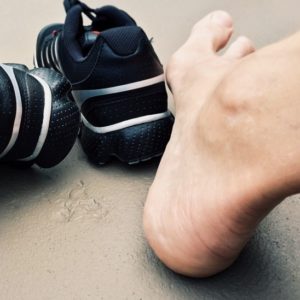 There are multiple types of neuromas, or benign growths of nerve tissue, that can occur within our bodies. In our feet, the most common is called a Morton’s Neuroma and is usually referred to as a pinched nerve. Most of the time this is a beginning tumor that will develop between the third and the fourth metatarsals of the foot. As the tissue around the nerve becomes more irritated and swollen, it will cause burning, tingling and numbness within the ball of the foot and can extend into the toes. Typically patients find relief by ceasing exercise, removing their shoes and massaging the affected area. At times the pain or discomfort may be described as having a marble or a stone on the bottom of their shoe.
There are multiple types of neuromas, or benign growths of nerve tissue, that can occur within our bodies. In our feet, the most common is called a Morton’s Neuroma and is usually referred to as a pinched nerve. Most of the time this is a beginning tumor that will develop between the third and the fourth metatarsals of the foot. As the tissue around the nerve becomes more irritated and swollen, it will cause burning, tingling and numbness within the ball of the foot and can extend into the toes. Typically patients find relief by ceasing exercise, removing their shoes and massaging the affected area. At times the pain or discomfort may be described as having a marble or a stone on the bottom of their shoe.
Causes:
There are a number of contributing factors that increase the risk of developing a neuroma. The first and most common factor is abnormal biomechanics such as a high or a low arched foot. This can change the position of the foot and toes, which leads to abnormal forces on the long bones in the foot and can cause an impingement of the adjacent nerves. Over time, this persistent irritation causes an abnormal thickening and inflammatory response of the lining of the nerve. Improper footwear with a high heel or narrow toe box can additionally aggravate symptoms by adding insult to injury. This repetitive stress over time can cause permanent damage to the nerve itself.
Things to Do to Prevent Pain:
The most sensible thing to do is wear shoes with plenty of room for the toes to move, low heels, and laces that will permit easy adjustments throughout the day. When picking a shoe, look for something with thick, shock-absorbent soles with a removable liner so that this can be adjusted to keep excessive pressure off of the foot. When choosing a dress shoe, high heels should be avoided whenever possible because they place an abnormal amount of pressure on the forefoot, which will aggravate any symptoms that are in the area. Removing the shoe, resting and massaging the painful area can sometimes help reduce the amount of pain experienced with neuromas. Ice and non-steroidal anti-inflammatories may also help. Resting the foot and massaging the affected area can temporarily alleviate neuroma pain. Using an ice pack will help to dull the pain and improve comfort. For a simple nerve irritation or beginning stages of neuroma type symptoms, using a thick-soled shoe with a wide toe box may allow symptoms to diminish over time. If pain continues, however, treatment by a Board Certified Podiatrist may be required.
Treatment Options:
There are many different treatment options available depending on the stage to which your symptoms have progressed. Adequate diagnosis is imperative in establishing a treatment protocol and when detected early, may prevent the need for surgical excision. This is typically done by clinical exam, utilizing radiograph and diagnostic ultrasound. Once a neuroma is isolated from other structures in the area that may cause similar symptoms, the appropriate treatment can be implemented.
The primary goal of treatment is to alleviate the pressure in the forefoot area that is contributing to the abnormal pressure. This is typically initially done by taping and padding the foot to redistribute the mechanical forces contributing to the pressure in the area. The majority of the time this can be accomplished by utilizing a custom orthotic device in a supportive athletic shoe in conjunction with non-steroidal anti-inflammatories. If pain persists, a series of ultrasound-guided injections may be required, with a cortico-steroid or a denaturing agent used to eliminate the nerve or release of the ligament in the area that may be contributing to abnormal pressure. Other options for nerve destruction include the use of radio- frequency or surgical excision.
Foot Pain is Not Normal
Remember, foot pain is not normal and any disruption of any of the small structures of your feet can cause pain. The best and most successful treatment is early detection by a Board Certified Podiatrist to implement early preventive measures. If symptoms continue to persist despite a conservative approach, remember that other options are available to prevent long-term consequences of this disorder. FBN
Written By Dr. Anthony Rosales







